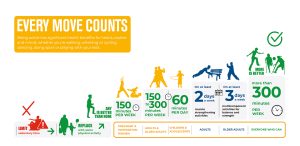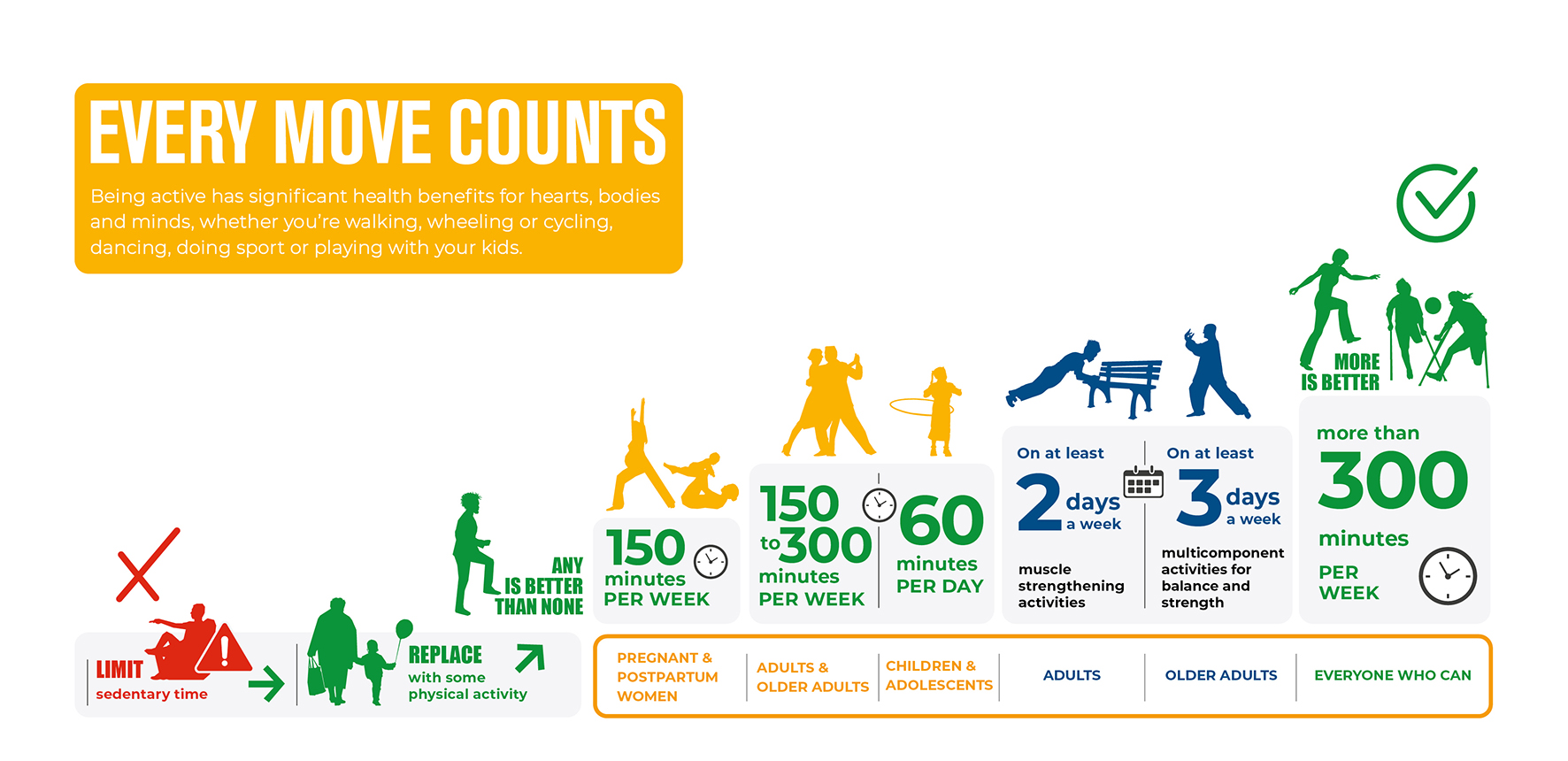
WHO defines physical activity as any bodily movement produced by skeletal muscles that requires energy expenditure. Physical activity refers to all movement including during leisure time, for transport to get to and from places, or as part of a person’s work. Both moderate- and vigorous-intensity physical activity improve health.
Popular ways to be active include walking, cycling, wheeling, sports, active recreation and play, and can be done at any level of skill and for enjoyment by everybody.
Regular physical activity is proven to help prevent and manage noncommunicable diseases such as heart disease, stroke, diabetes and several cancers. It also helps prevent hypertension, maintain healthy body weight and can improve mental health, quality of life and well-being.
How much of physical activity is recommended?
WHO guidelines and recommendations provide details for different age groups and specific population groups on how much physical activity is needed for good health.
In a 24-hour day, infants (less than 1 year) should:
- be physically active several times a day in a variety of ways, particularly through interactive floor-based play; more is better. For those not yet mobile, this includes at least 30 minutes in prone position (tummy time) spread throughout the day while awake;
- not be restrained for more than 1 hour at a time (e.g., prams/strollers, high chairs, or strapped on a caregiver’s back);
- Screen time is not recommended.
- When sedentary, engaging in reading and storytelling with a caregiver is encouraged; and
- have 14-17h (0-3 months of age) or 12-16h (4-11 months of age) of good quality sleep, including naps.
In a 24-hour day, children 1-2 years of age should:
- spend at least 180 minutes in a variety of types of physical activities at any intensity, including moderate- to vigorous-intensity physical activity, spread throughout the day; more is better;
- not be restrained for more than 1 hour at a time (e.g., prams/strollers, high chairs, or strapped on a caregiver’s back) or sit for extended periods of time.
- For 1 year olds, sedentary screen time (such as watching TV or videos, playing computer games) is not recommended.
- For those aged 2 years, sedentary screen time should be no more than 1 hour; less is better.
- When sedentary, engaging in reading and storytelling with a caregiver is encouraged; and
- have 11-14h of good quality sleep, including naps, with regular sleep and wake-up times.
In a 24-hour day, children 3-4 years of age should:
- spend at least 180 minutes in a variety of types of physical activities at any intensity, of which at least 60 minutes is moderate- to vigorous-intensity physical activity, spread throughout the day; more is better;
- not be restrained for more than 1 hour at a time (e.g., prams/strollers) or sit for extended periods of time.
- Sedentary screen time should be no more than 1 hour; less is better.
- When sedentary, engaging in reading and storytelling with a caregiver is); encourage; and
- have 10-13h of good quality sleep, which may include a nap, with regular sleep and wake-up times.
- should do at least an average of 60 minutes per day of moderate-to-vigorous intensity, mostly aerobic, physical activity, across the week.
- should incorporate vigorous-intensity aerobic activities, as well as those that strengthen muscle and bone, at least 3 days a week.
- should limit the amount of time spent being sedentary, particularly the amount of recreational screen time.
- should do at least 150–300 minutes of moderate-intensity aerobic physical activity;
- or at least 75–150 minutes of vigorous-intensity aerobic physical activity; or an equivalent combination of moderate- and vigorous-intensity activity throughout the week
- should also do muscle-strengthening activities at moderate or greater intensity that involve all major muscle groups on 2 or more days a week, as these provide additional health benefits.
- may increase moderate-intensity aerobic physical activity to more than 300 minutes; or do more than 150 minutes of vigorous-intensity aerobic physical activity; or an equivalent combination of moderate- and vigorous-intensity activity throughout the week for additional health benefits.
- should limit the amount of time spent being sedentary. Replacing sedentary time with physical activity of any intensity (including light intensity) provides health benefits, and
- to help reduce the detrimental effects of high levels of sedentary behaviour on health, all adults and older adults should aim to do more than the recommended levels of moderate- to vigorous-intensity physical activity
Adults aged 65 years and above
- Same as for adults; and
- as part of their weekly physical activity, older adults should do varied multicomponent physical activity that emphasizes functional balance and strength training at moderate or greater intensity, on 3 or more days a week, to enhance functional capacity and to prevent falls.
Pregnant and postpartum women
All pregnant and postpartum women without contraindication should:
- do at least 150 minutes of moderate-intensity aerobic physical activity throughout the week
- incorporate a variety of aerobic and muscle-strengthening activities
- should limit the amount of time spent being sedentary. Replacing sedentary time with physical activity of any intensity (including light intensity) provides health benefits.
People living with chronic conditions (hypertension, type 2 diabetes, HIV and cancer survivors)
- should do at least 150–300 minutes of moderate-intensity aerobic physical activity;
- or at least 75–150 minutes of vigorous-intensity aerobic physical activity; or an equivalent combination of moderate- and vigorous-intensity activity throughout the week
- should also do muscle-strengthening activities at moderate or greater intensity that involve all major muscle groups on 2 or more days a week, as these provide additional health benefits.
- as part of their weekly physical activity, older adults should do varied multicomponent physical activity that emphasizes functional balance and strength training at moderate or greater intensity, on 3 or more days a week, to enhance functional capacity and to prevent falls.
- may increase moderate-intensity aerobic physical activity to more than 300 minutes; or do more than 150 minutes of vigorous-intensity aerobic physical activity; or an equivalent combination of moderate- and vigorous-intensity activity throughout the week for additional health benefits.
- should limit the amount of time spent being sedentary. Replacing sedentary time with physical activity of any intensity (including light intensity) provides health benefits, and
- to help reduce the detrimental effects of high levels of sedentary behaviour on health, all adults and older adults should aim to do more than the recommended levels of moderate- to vigorous-intensity physical activity.
Children and adolescents living with disability:
should do at least an average of 60 minutes per day of moderate-to-vigorous intensity, mostly aerobic, physical activity, across the week.
should incorporate vigorous-intensity aerobic activities, as well as those that strengthen muscle and bone, at least 3 days a week.
should limit the amount of time spent being sedentary, particularly the amount of recreational screen time.
Adults living with disability:
should do at least 150–300 minutes of moderate-intensity aerobic physical activity;
or at least 75–150 minutes of vigorous-intensity aerobic physical activity; or an equivalent combination of moderate- and vigorous-intensity activity throughout the week
should also do muscle-strengthening activities at moderate or greater intensity that involve all major muscle groups on 2 or more days a week, as these provide additional health benefits.
As part of their weekly physical activity, older adults should do varied multicomponent physical activity that emphasizes functional balance and strength training at moderate or greater intensity, on 3 or more days a week, to enhance functional capacity and to prevent falls.
may increase moderate-intensity aerobic physical activity to more than 300 minutes; or do more than 150 minutes of vigorous-intensity aerobic physical activity; or an equivalent combination of moderate- and vigorous-intensity activity throughout the week for additional health benefits.
should limit the amount of time spent being sedentary. Replacing sedentary time with physical activity of any intensity (including light intensity) provides health benefits, and
to help reduce the detrimental effects of high levels of sedentary behaviour on health, all adults and older adults should aim to do more than the recommended levels of moderate- to vigorous-intensity physical activity.
It is possible to avoid sedentary behaviour and be physically active while sitting or lying. E.g. Upper body led activities, inclusive and/or wheelchair-specific sport and activities.




